IT Asset Management Software is a program that manages and monitors the IT assets found in a network. With the help of IT asset management solutions, an asset can be tracked for its entire duration in the organization. You can manage LAN as well as work from home endpoints from a central location. Using IT Asset management (ITAM) software, you can manage both hardware and software assets in your network anywhere, anytime, from your laptop or mobile phone.
Similarly, an ITAM software also helps in keeping track of digital assets. With the help of asset scans available in an ITAM software, you can easily configure alerts to notify you regarding any change detected in the hardware or software inventory. Endpoint Central's IT Asset Management Software is one of the best ITAM software that offers effortless management of physical and digital assets along with predefined inventory reports and email notifications to track, monitor and manage everything from a single console.
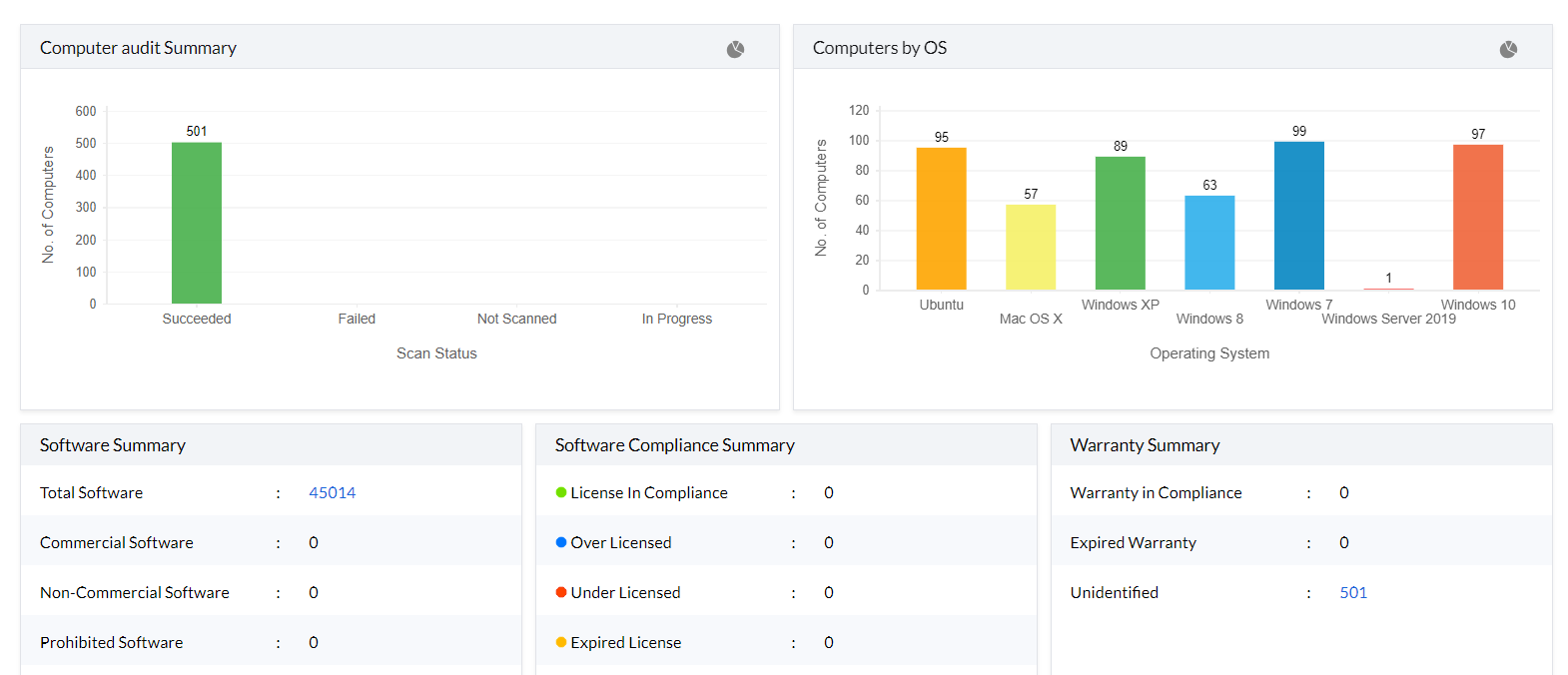
IT Asset Tracking
Tracking your IT assets helps track the device's entire lifecycle, from provisioning to disposal. By doing so, assets are utilized to their full potential and are replaced or retired when necessary. Organizations can reduce operational costs by monitoring their assets' location, condition, and usage through effective asset monitoring. As a result, unnecessary purchases, losses, thefts, and depreciation can be avoided, which can save money. Resource allocation and asset utilization also improves through efficient asset tracking.
Key Features of IT Asset Management tool
Here is a complete list of IT asset tracking and management features offered by us for a comprehensive IT asset management (ITAM):
Periodic Asset Scans
In today's fast-paced world, devices are replaced or upgraded within the blink of an eye, at an alarming frequency. It is your job as an IT Administrator to keep track of all these changes/additions using an IT asset management system and ensure that only authorized devices are connected to your network. This IT asset tracking and management software scans your network periodically to fetch software and hardware inventory details and detect any changes in your network. You can perform asset scanning in the following ways:
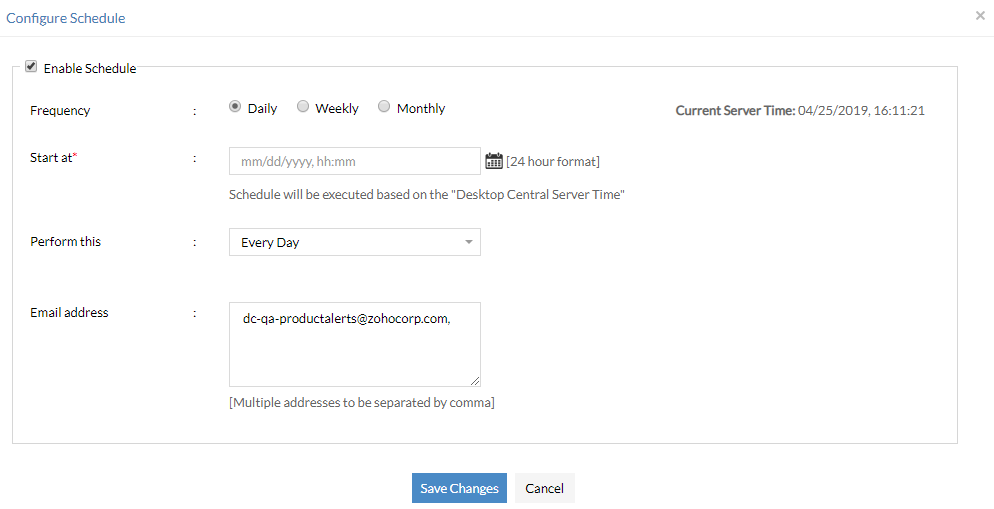
- Post-install
This scan is initiated when the agent is installed on the machine for the first time. It occurs immediately after the installation of the agent to gather all necessary details of the machine.
- Scheduled
This type of scan is scheduled in advance to run at specific intervals or times. It's a regular, automated scan that occurs based on a predefined schedule.
- Scheduled-user
Similar to a scheduled scan but these are triggered when a scan is scheduled at a pre-defined time, and a less privileged user happens to be logged into the system.
- Notify
A notify scan is triggered when a software is installed or uninstalled. It occurs as a response to changes in the system software configuration, alerting the system to perform a scan in response to such events.
- Notify-user
This scan is similar to the notify scan but focuses on user-specific software. It's triggered when user-specific software is installed or uninstalled.
- On-demand
This scan is initiated manually by the Administrator from the server. It allows for immediate, user-initiated scans when there is a need for specific system checks or troubleshooting.
- Tray-icon
A scan that is manually triggered by the user from the agent tray icon. Users can initiate this type of scan through the system tray, providing them with a convenient way to perform scans when needed.
- FS-server
This is a quick scan triggered by the server when the previously parsed differential data is only partially saved in the server. The full scan ensures that the necessary details is entirely parsed to the server.
Software License Management
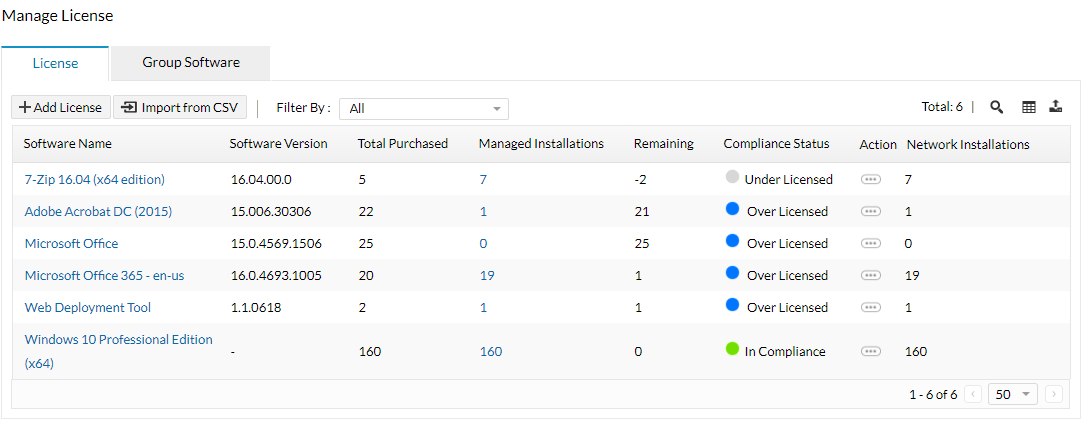
An IT asset management system ensures you're license compliant at all times and helps you steer clear of hefty non-compliance fines during a software audit. ManageEngine's IT asset tracking and management software makes this process a whole lot easier by detecting your compliance status automatically. When a software is found to be under licensed, you can either add more licenses or uninstall the software from required number of computers using IT Asset Management software like Endpoint Central, also available on mobile app
Learn more about software license compliance.
Hardware Warranty Management
Keeping track of hardware warranty with an IT asset management tool can help you save unnecessary maintenance costs. This IT Asset Management software greatly assists in computer asset management by automatically detecting warranty details for Dell, Lenovo, Toshiba and HP devices. The asset management software also has pre-configured reports for computers with about-to-expire warranty and computers for which the warranty has expired already.
Real Time Inventory Alerts
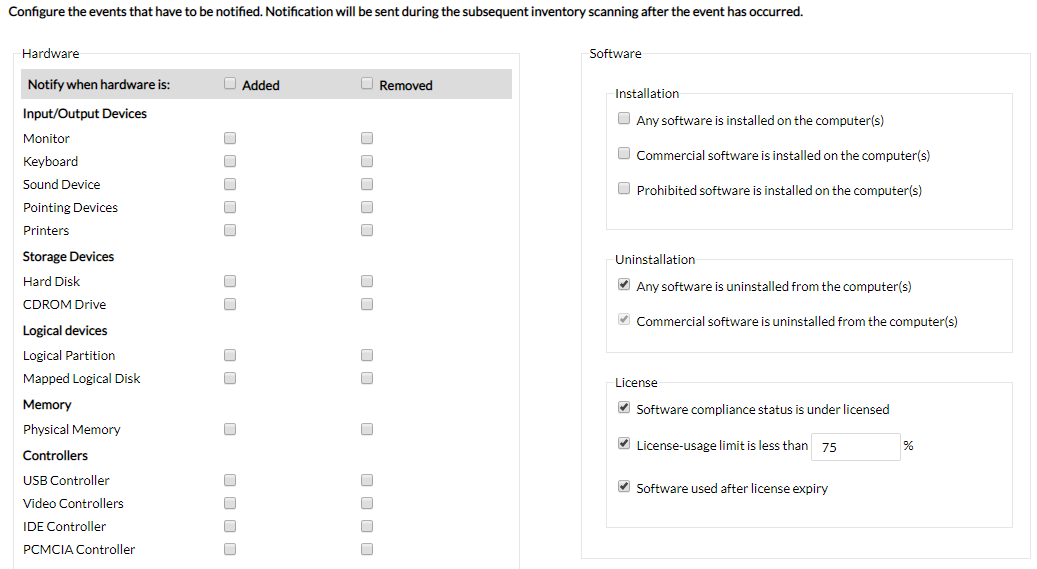
With the help of this asset tracking software you can set up real-time notifications for whenever a new software is installed, a hardware component is added/removed, software is under licensed or is being used after license expiry, commercial software is installed/uninstalled, disk space on a computer falls below a specified percentage, and more in just a few clicks.
Software Metering
You can cut down on significant expenses with an IT asset management tool by monitoring the usage of commercial software, and ensuring that you're using the licenses efficiently. With Endpoint Central, Software asset management is now easier; you can view detailed reports and determine whether the software usage justifies the cost, which helps you make informed procurement decisions.
Certificate Management
In addition to using passwords for security and authentication, many organizations now prefer to use digitally signed certificates for authentication before allowing users to access Exchange servers, Wi-Fi, VPNs, and other such applications. Create, distribute, and renew digitally signed certificates with Endpoint Central.
There are two types of certificates that are commonly used:
- Trust certificates
A single trust certificate is used by admins to authenticate all users in the organization. The certificate must be present on the device in order for the user to be able to authenticate their devices. This can be done by distributing the certificate using Endpoint Central.
- User-specific certificates
Certificate Authorities (CAs) are responsible for issuing certificates to organizations and create certificates for each user. When integrated with Endpoint Central, the CA authority creates and distributes these certificates.
Geofencing
A geofence is a virtual fence based on a geo-location range that ensures certain actions are performed on the device automatically when it leaves the specified range. It creates a virtual defense to protect corporate devices containing sensitive enterprise data that cannot leave a certain location/range.
Endpoint Central ensures devices leaving the geofence are automatically marked as non-compliant and thus, triggers a set of actions - from passive actions such as notifying administrators, locking the device, wiping the device data or executing preferred security commands.
Power Management
By managing and optimizing the power consumption of hardware in your network, Endpoint Central saves you money and energy.
- Create, modify, and apply power schemes based on branches/departments/job roles.
- Shutdown, hibernate or standby an idle computer to save power consumption.
- Monitor the battery levels of critical business devices.
- In older models that do not support power schemes, you can turn off the screensavers.
Read more on power management here.
USB Device Management
Pen drives, CDs, and any other portable storage devices can jeopardize your company's data or security if not monitored by your IT team. By blocking or disabling USB devices, you can limit their use based on the roles and departments. You can restrict not only by computer and user level, but also by manufacturer type, facilitating more accessibility. Enable/disable the following USB devices for users and computers:
- Mouse
- Disk drive
- CD-ROM
- Floppy disk
- Bluetooth
- Image
- Printer
- Modem
- Apple USB Devices
- Portable storage devices
Instead of disabling or enabling USB devices, you can choose to just record these activities for future auditing. Endpoint Central helps track the usage of USB devices and provides you with all the necessary information such as:
- Device name
- User name
- Device type
- Time duration
- Manufacturer and more.
Read more on USB device management here.
Software and Hardware Inventory
Staying up-to-date and informed about the assets present in your network is one of the benefits of ITAM. The IT asset management solution empowers you to make data-backed decisions about acquiring new assets, which will lead to cutting unnecessary expenses. Endpoint Central's IT Asset Management (ITAM) software offers in-depth reports related to both hardware and software asset management along with all the relevant metrics, and this information is easily accessible from your mobile phone, using mobile app.
File Scanning
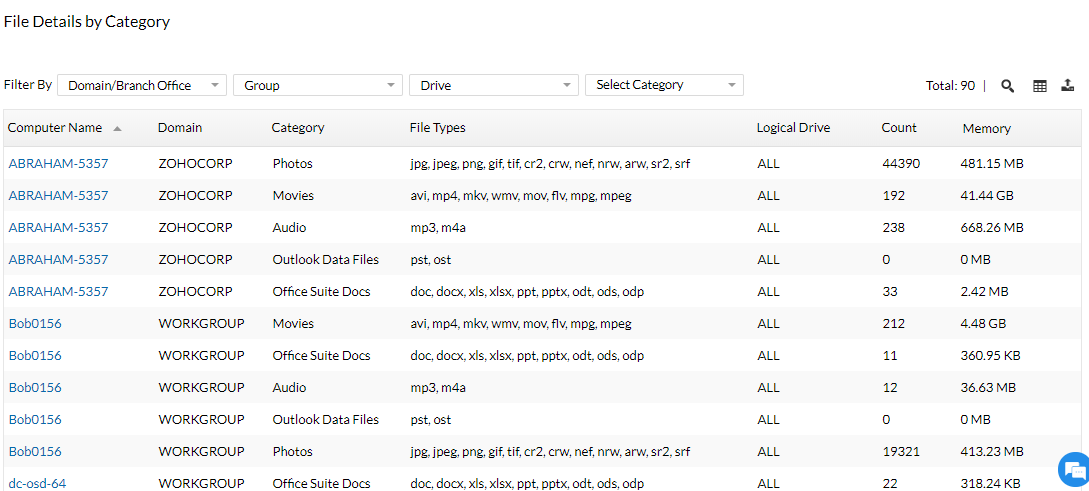
Using asset tracking software, gain visibility on the type of files present in your network by setting up rules and scheduling scans. An IT asset management tool allows you to set up file scan rules(audio, video, documents, etc) and determine how much space is being occupied by these files. If required, you can notify users to delete unnecessary files on computers with low free disk space using an ITAM tool.
Prohibit Software and Block Executables
As a system administrator, you need to ensure that none of the computers have any prohibited software installed on them. Using this IT asset management software, you can prohibit software and create an auto uninstall policy within a few clicks. You also have the option to notify the user and request them to uninstall the software on their own with an IT asset management system. In some cases, malicious software doesn't need to be installed on the computer and can be run from an external drive. Our IT asset management solution allows you to prevent the usage of such applications by blocking these executables. This will prevent the application from being executed which will in turn prevent attacks/data breaches.
IT Asset Management (ITAM) Best Practices
Because of the sheer number of assets in enterprises, IT asset management can be intimidating. Here are a few best practices you can weave into your existing ITAM strategy to ensure optimum results:
- Keep redefining and evolving your strategy. IT asset management (ITAM) is not a destination, it is a process and needs to be treated as such.
- Set up real time notifications for any hardware/software changes within your network in your IT asset management software, so that you can detect anomalies and remediate right away.
- Before renewing the license for a commercial software, analyze the usage statistics thoroughly to ensure that you buy only what is required. Accurate reports from an IT asset management software helps you make informed decisions with minimal effort.
- Enable real-time alerts for:
- When the license status is under-compliant
- When a commercial software is installed/uninstalled within your network
- When the license for a commercial software is about to expire
FAQs about ITAM
What is IT Asset Management (ITAM)?
ITAM is the process of identifying, discovering, procuring, managing, monitoring and disposing all the company-owned data, devices and software elements present in an enterprise's network. An ITAM tool ensures a centralized view of all the assets present in the network along with software and hardware details. Having a thorough ITAM process in place can empower you to make data-backed, strategic decisions about acquiring new assets, thereby cutting down unnecessary expenses. An IT Asset Management software also allows you to manage software licenses, monitor changes in the inventory and download customized reports with a click of a button.
What is the need for an IT Asset Management Solution?
IT Asset Management (ITAM) is all about monitoring and managing the assets available in your network. These assets play a huge role in the productivity of any organization. It is necessary to manage these assets with an ITAM solution to avoid risks and unwanted expenditure and improve efficiency and productivity. Equipping yourself with a comprehensive ITAM tool helps in monitoring the assets in your network, and reduce the downtime and discover, repair or replace damaged assets quickly. In work from home scenarios, an IT Asset Management (ITAM) software can help in monitoring the logon activity of employees with the list of active computers. Alerts can be configured to notify you about the changes in the hardware and software inventory. Unwanted applications can be prohibited or uninstalled from the assets automatically. Our IT Asset Management module provides an efficient ITAM solution that has ability to discover, manage and monitor IT Assets.
What is the difference between ITAM and ITSM?
- ITAM stands for Information Technology Asset Management and ITSM stands for Information Technology Service Management.
- ITAM focuses on hardware, software and networks of an organization whereas ITSM focuses on its customer-oriented IT services.
- ITAM and ITSM are both branches of IT Management but are mutually exclusive in nature.
- While ITAM aims on magnifying the value of the company's assets using an ITAM solution, ITSM aims at magnifying the IT service delivery of the company.
What are the different types of IT Asset Management?
Hardware asset managementis the part of an ITAM system that involves the management of tangible devices such as laptops, desktops, keyboards, printers, etc. Our ITAM software allows you to categorize your computers based on OS, manufacturer, disk usage, age and device type and hardware assets based on manufacturer and types. You can also configure alerts to notify you if any new hardware is detected in your network with our IT asset management solution.
Software asset management of an ITAM system involves the management of all the software applications/executable that are installed on endpoints in a network within an organization using an IT asset management system. It also involves software license management, software metering and much more. You can also prohibit certain applications by adding them on the prohibited software list. Our ITAM software also allows you to configure compliance alerts to stay software license compliant at all times.
Digital asset management is a part of an ITAM system that deals with the management of documents, pictures, videos or in general, data in any form that has been paid for, produced or is being managed by your enterprise.
What are the benefits of IT Asset Management Tools?
Enterprises now-a-days can have anywhere between 1000 to 100,000+ devices in their networks and it goes without saying that a centralized and automated IT asset management software is required to track and manage these IT assets. ITAM process not only allows you to do that, but it also gives you the visibility and insights required to strategize and make informed IT asset procurement decisions while mitigating the risks in the most cost-efficient way possible. Real-time asset tracking is one of the unique features of ITAM software enhancing the tracking process. An IT asset manager can also be cloud-based offering flexibility in access and management. Also, consistent focus on assets by an ITAM software allows little room for unexpected asset failure and other associated problems.
Importance of having an ITAM solution in an organization
- IT asset management software is crucial to any enterprise that possesses numerous endpoints in its network. Let us say that an enterprise has 500 computers and other hardware components like keyboard, mouse, etc. Each of these desktops and laptops will have various applications installed in them and computer asset management without an ITAM system will become an onerous task. An IT asset manager is required to keep track of all these IT assets in an enterprise.
- An ITAM process enables an IT admin to monitor the number of assets available to avoid unwanted expenditures, repetitive purchases, and productivity and security issues.
- The applications installed in a computer may contain prohibited software that may raise productivity and compliance issues. IT asset management software also allows an admin to monitor and manage software assets by overseeing licensed software usage and prohibiting unwanted software.
- An ITAM tool also allows scanning of specific file types to review the memory usage of these files. Alerts can be configured for every change induced in these assets, thus giving the user and admin control and clarity over the IT assets.
- A comprehensive IT asset management solution is necessary to offer accurate asset reports irrespective of the number of assets present in the organization. Also understanding the usage of your assets with an IT asset management solution gives you greater control over the efficiency of the organization.
IT Asset Management Made Simple
IT asset management is, as stated above, performing certain operations on hardware and software assets of the organization like identifying, discovering, procuring, managing, monitoring and disposing them. All types of IT Asset Management like Hardware Asset Management, Software Asset Management and Digital Asset Management are of critical importance for the smooth functioning of any organization. As assets play a huge role in ensuring a productive workflow of an organization, managing them by a suitable IT asset manager is of paramount importance. By monitoring and managing assets with an ITAM software to reduce the turn-around-time in replacing or repairing damaged assets, organizations can save a lot of time, manpower and money. ManageEngine's Endpoint Central is one of the best IT asset management softwares that helps an IT administrator in automating many of the routine tasks and offer a comprehensive overview of the status of assets in the network. A simple IT asset management software like Endpoint Central makes your entire asset management process easier yet effective.
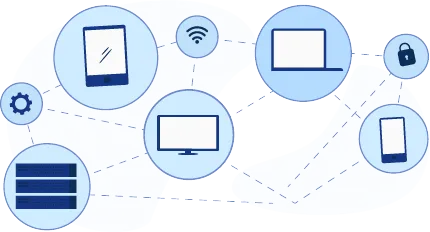
If you are looking for an exclusive MSP-centric solution for endpoint management, Endpoint Central MSP today!

"Endpoint Central provides me with a complete inventory of all of my hardware and software assets. This helps me to track the status of my assets, identify any potential problems, and make better decisions about IT spending."
Adnan R,
Review collected by and hosted on G2.